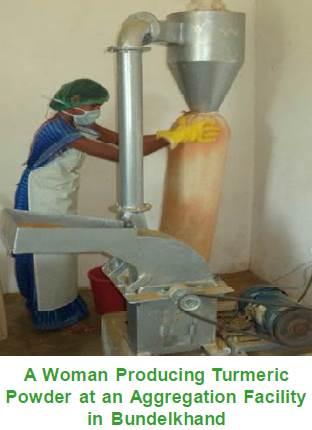|
Spices Value Chain Development B undelkhand is a semi-arid region in central India characterised by poor human development indicators and degraded status of natural resources. Agriculture is the mainstay of the Bundelkhand economy with 90% of the population being dependent on agriculture that is 75% rain-fed. Poor productivity, resulting from both poor soil conditions and adherence to obsolete and resource inefficient farming practices has been the bane of the farming community. 67% of farmers in the region are small and marginal farmers who ow n less than two hectares of land and cannot realise economies of scale. Recurrent drought over the past few years
has rendered small farms unviable, leading to distress migration and
abandoned farmlands. Poor natural resource base coupled with
unsustainable management practices has led to high distress in the
farming sector leading to a vicious cycle of livelihood insecurity,
poverty and debt. n less than two hectares of land and cannot realise economies of scale. Recurrent drought over the past few years
has rendered small farms unviable, leading to distress migration and
abandoned farmlands. Poor natural resource base coupled with
unsustainable management practices has led to high distress in the
farming sector leading to a vicious cycle of livelihood insecurity,
poverty and debt.
However, it is the agriculture sector that if supported with appropriate interventions can present opportunities for boosting incomes and stimulating economic development at scale. Bundelkhand region is known for the quality of its spices like turmeric, ginger and chilli. However, an analysis of the sub sector reveals that overall productivity and production are on a steady decline and the lack of resources and technical know-how is limiting the economic potential of this valuable agri-produce. The lack of access to formal market channels results in poor or unfair prices for the farmers’ produce. Farmers and local communities garner the minimum share of the economic value of their produce losing their fair share to middlemen with access to markets. The spices grown here are traded to other regions for processing and the local community is not accruing the benefits of spice production in the region. The lack of technical knowledge and business expertise, poor post-harvest management infrastructure and inadequate market information has limited the communities from realising the economic potential of their produce. This can be done by making interventions at various points in the value chain which includes: • Increase On - Farm Production and Productivity of Spices: Persistence of chronic droughts and poor natural resource management over the years has led to decline in production and productivity of spices like ginger, turmeric and chillis. Poor knowledge on improved farming practices and high levels of crop damage thereof is dissuading farmers from taking these crops which might result in the loss of a high value produce from the region. Spice producers can be trained and supported to adopt improved and organic farming practices that are resource efficient, boost productivity and yield environment co-benefits in the short and the long run.• Promote Farm Aggregation and Processing of Spices: The creation of aggregation platforms for spice growing farmers can help them collectively access inputs and extended market channels for realising fair prices. The collection of farm inputs will increase their bargaining power in the market. Equipped with post-harvest management infrastructure, the aggregation centres can also serve as common facility centres to cater to the processing requirements of farmers to realise improved returns from the market. If dried and processed, the processing of spices can help the farmers realise upto 150% increase in revenue as compared to raw/farm fresh spices.• Establish Food Processing Businesses: The spices also present an opportunity for creating value addition centres for food processing. A large variety of ginger and chilli based condiments, candies, sauces, pickles and juices can be developed from the large variety of products grown in Bundelkhand. These centres can create large employment and can lead to increase in revenues more than 200% as compared to farm produce.Development Alternatives has undertaken an initiative to promote the value chain of spices in Bundelkhand through such interventions. So far, 100 farmers have benefitted from this intervention and an aggregation platform employing six women for drying and processing of spices has been established. This model will be scaled up for replication to help enhance incomes and stimulate development. q Chitrangna Dewan
|